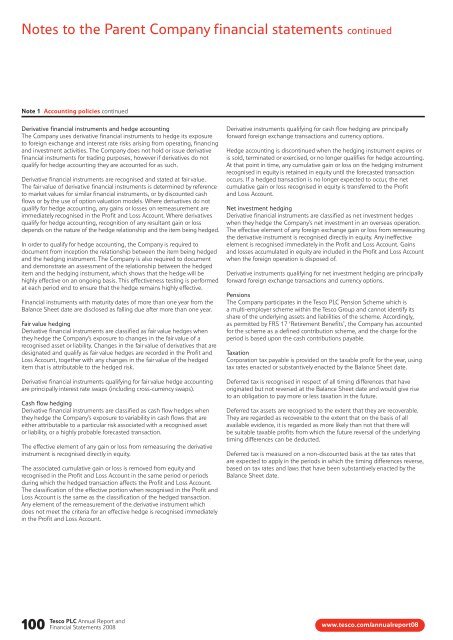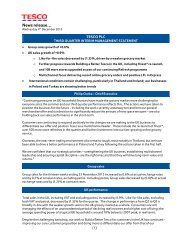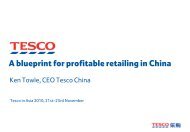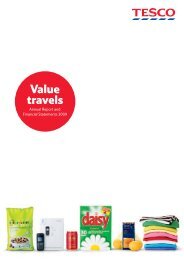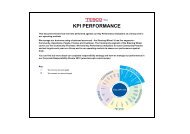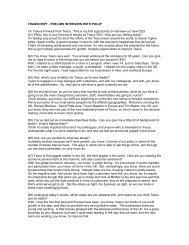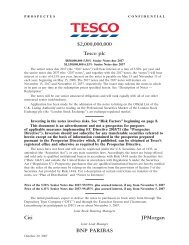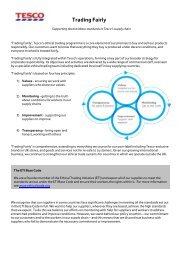Tesco plc Annual Report and Financial Statements 2008
Tesco plc Annual Report and Financial Statements 2008
Tesco plc Annual Report and Financial Statements 2008
Create successful ePaper yourself
Turn your PDF publications into a flip-book with our unique Google optimized e-Paper software.
Notes to the Parent Company financial statements continued<br />
Note 1 Accounting policies continued<br />
Derivative financial instruments <strong>and</strong> hedge accounting<br />
The Company uses derivative financial instruments to hedge its exposure<br />
to foreign exchange <strong>and</strong> interest rate risks arising from operating, financing<br />
<strong>and</strong> investment activities. The Company does not hold or issue derivative<br />
financial instruments for trading purposes, however if derivatives do not<br />
qualify for hedge accounting they are accounted for as such.<br />
Derivative financial instruments are recognised <strong>and</strong> stated at fair value.<br />
The fair value of derivative financial instruments is determined by reference<br />
to market values for similar financial instruments, or by discounted cash<br />
flows or by the use of option valuation models. Where derivatives do not<br />
qualify for hedge accounting, any gains or losses on remeasurement are<br />
immediately recognised in the Profit <strong>and</strong> Loss Account. Where derivatives<br />
qualify for hedge accounting, recognition of any resultant gain or loss<br />
depends on the nature of the hedge relationship <strong>and</strong> the item being hedged.<br />
In order to qualify for hedge accounting, the Company is required to<br />
document from inception the relationship between the item being hedged<br />
<strong>and</strong> the hedging instrument. The Company is also required to document<br />
<strong>and</strong> demonstrate an assessment of the relationship between the hedged<br />
item <strong>and</strong> the hedging instrument, which shows that the hedge will be<br />
highly effective on an ongoing basis. This effectiveness testing is performed<br />
at each period end to ensure that the hedge remains highly effective.<br />
<strong>Financial</strong> instruments with maturity dates of more than one year from the<br />
Balance Sheet date are disclosed as falling due after more than one year.<br />
Fair value hedging<br />
Derivative financial instruments are classified as fair value hedges when<br />
they hedge the Company’s exposure to changes in the fair value of a<br />
recognised asset or liability. Changes in the fair value of derivatives that are<br />
designated <strong>and</strong> qualify as fair value hedges are recorded in the Profit <strong>and</strong><br />
Loss Account, together with any changes in the fair value of the hedged<br />
item that is attributable to the hedged risk.<br />
Derivative financial instruments qualifying for fair value hedge accounting<br />
are principally interest rate swaps (including cross-currency swaps).<br />
Cash flow hedging<br />
Derivative financial instruments are classified as cash flow hedges when<br />
they hedge the Company’s exposure to variability in cash flows that are<br />
either attributable to a particular risk associated with a recognised asset<br />
or liability, or a highly probable forecasted transaction.<br />
The effective element of any gain or loss from remeasuring the derivative<br />
instrument is recognised directly in equity.<br />
The associated cumulative gain or loss is removed from equity <strong>and</strong><br />
recognised in the Profit <strong>and</strong> Loss Account in the same period or periods<br />
during which the hedged transaction affects the Profit <strong>and</strong> Loss Account.<br />
The classification of the effective portion when recognised in the Profit <strong>and</strong><br />
Loss Account is the same as the classification of the hedged transaction.<br />
Any element of the remeasurement of the derivative instrument which<br />
does not meet the criteria for an effective hedge is recognised immediately<br />
in the Profit <strong>and</strong> Loss Account.<br />
100<br />
<strong>Tesco</strong> PLC <strong>Annual</strong> <strong>Report</strong> <strong>and</strong><br />
<strong>Financial</strong> <strong>Statements</strong> <strong>2008</strong><br />
Derivative instruments qualifying for cash flow hedging are principally<br />
forward foreign exchange transactions <strong>and</strong> currency options.<br />
Hedge accounting is discontinued when the hedging instrument expires or<br />
is sold, terminated or exercised, or no longer qualifies for hedge accounting.<br />
At that point in time, any cumulative gain or loss on the hedging instrument<br />
recognised in equity is retained in equity until the forecasted transaction<br />
occurs. If a hedged transaction is no longer expected to occur, the net<br />
cumulative gain or loss recognised in equity is transferred to the Profit<br />
<strong>and</strong> Loss Account.<br />
Net investment hedging<br />
Derivative financial instruments are classified as net investment hedges<br />
when they hedge the Company’s net investment in an overseas operation.<br />
The effective element of any foreign exchange gain or loss from remeasuring<br />
the derivative instrument is recognised directly in equity. Any ineffective<br />
element is recognised immediately in the Profit <strong>and</strong> Loss Account. Gains<br />
<strong>and</strong> losses accumulated in equity are included in the Profit <strong>and</strong> Loss Account<br />
when the foreign operation is disposed of.<br />
Derivative instruments qualifying for net investment hedging are principally<br />
forward foreign exchange transactions <strong>and</strong> currency options.<br />
Pensions<br />
The Company participates in the <strong>Tesco</strong> PLC Pension Scheme which is<br />
a multi-employer scheme within the <strong>Tesco</strong> Group <strong>and</strong> cannot identify its<br />
share of the underlying assets <strong>and</strong> liabilities of the scheme. Accordingly,<br />
as permitted by FRS 17 ‘Retirement Benefits’, the Company has accounted<br />
for the scheme as a defined contribution scheme, <strong>and</strong> the charge for the<br />
period is based upon the cash contributions payable.<br />
Taxation<br />
Corporation tax payable is provided on the taxable profit for the year, using<br />
tax rates enacted or substantively enacted by the Balance Sheet date.<br />
Deferred tax is recognised in respect of all timing differences that have<br />
originated but not reversed at the Balance Sheet date <strong>and</strong> would give rise<br />
to an obligation to pay more or less taxation in the future.<br />
Deferred tax assets are recognised to the extent that they are recoverable.<br />
They are regarded as recoverable to the extent that on the basis of all<br />
available evidence, it is regarded as more likely than not that there will<br />
be suitable taxable profits from which the future reversal of the underlying<br />
timing differences can be deducted.<br />
Deferred tax is measured on a non-discounted basis at the tax rates that<br />
are expected to apply in the periods in which the timing differences reverse,<br />
based on tax rates <strong>and</strong> laws that have been substantively enacted by the<br />
Balance Sheet date.<br />
www.tesco.com/annualreport08


